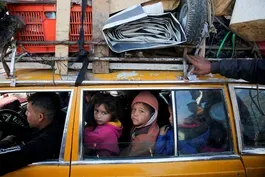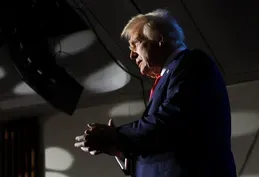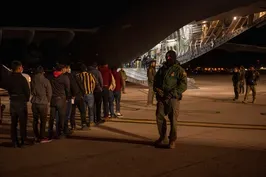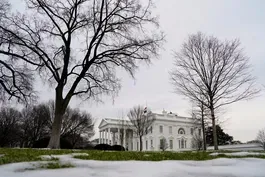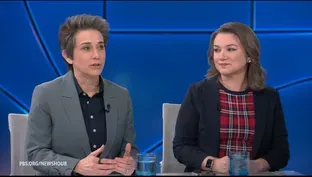
Museum preserves shoes of youngest Auschwitz victims
Clip: 1/27/2025 | 7m 48sVideo has Closed Captions
Museum works to preserve shoes belonging to Auschwitz's youngest victims
On the 80th anniversary of its liberation, survivors of the Holocaust gathered at the extermination camp at Auschwitz-Birkenau in Poland. Of the more than six million Jews murdered by the Nazis, 1.1 million were killed at Auschwitz, nearly a quarter million children. Special correspondent Malcolm Brabant reports on a project to preserve the shoes of the war's smallest victims.
Major corporate funding for the PBS News Hour is provided by BDO, BNSF, Consumer Cellular, American Cruise Lines, and Raymond James. Funding for the PBS NewsHour Weekend is provided by...

Museum preserves shoes of youngest Auschwitz victims
Clip: 1/27/2025 | 7m 48sVideo has Closed Captions
On the 80th anniversary of its liberation, survivors of the Holocaust gathered at the extermination camp at Auschwitz-Birkenau in Poland. Of the more than six million Jews murdered by the Nazis, 1.1 million were killed at Auschwitz, nearly a quarter million children. Special correspondent Malcolm Brabant reports on a project to preserve the shoes of the war's smallest victims.
How to Watch PBS News Hour
PBS News Hour is available to stream on pbs.org and the free PBS App, available on iPhone, Apple TV, Android TV, Android smartphones, Amazon Fire TV, Amazon Fire Tablet, Roku, Samsung Smart TV, and Vizio.
Providing Support for PBS.org
Learn Moreabout PBS online sponsorshipAMNA NAWAZ: Survivors of the Holocaust gathered at one of the scenes of the Nazis' gravest crimes today, the extermination camp at Auschwitz-Birkenau in Poland, on this 80th anniversary of its liberation.
Of the more than six million Jews murdered by the Nazis, 1.1 million were killed at Auschwitz, and, among them, nearly a quarter-million were children.
Many of the survivors there today were just children when they were marched through the camp on little feet wearing little shoes.
Now a project to preserve those shoes is renewing attention the war's smallest victims.
Here's special correspondent Malcolm Brabant.
MALCOLM BRABANT: Behind guard towers and disconnected electrified barbed-wire fences, dedicated restorers are working with great tenderness in a place synonymous with unspeakable cruelty.
MARCIN NORAS, Historian, Auschwitz Shoe Conservation Project: Time is our main enemy here.
MALCOLM BRABANT: Historian Marcin Noras has been working for two years preserving shoes belonging to the extermination camps youngest victims.
MARCIN NORAS: The leather itself is pretty resilient when it comes to the passage of time.
Metal, however, is our main issue.
Metal starts corroding.
That corrosion triggers the degradation process as in everything else.
MALCOLM BRABANT: Although Auschwitz was turned into a museum a year after being liberated by the Soviet Red Army in January 1945, it remains a crime scene.
MARCIN NORAS: Basically, we are dealing with evidence of a crime.
This is the philosophy adopted by the museum that this is evidence of a crime, one of the largest crimes in world history.
MALCOLM BRABANT: The conservators are working on 8,000 children's shoes, a fraction of the 120,000 in the Auschwitz collection.
MARCIN NORAS: Preserving these objects, this evidence is about preserving the memory of the victims of the crime, preserving their identity often.
MALCOLM BRABANT: In all, 1.5 million children were murdered during the Holocaust; 235,000 perished here at Auschwitz-Birkenau.
Frequently, children were the first to be exterminated because the Nazis believed they were too weak to be forced to work and were a waste of food.
Eighty years ago, the air here was heavy with the stench of death, but not anymore.
Over time, the ashes of the children have been absorbed into the earth, and they are beneath my feet and beneath the feet of millions who walk past this drawing of an orchestra serenading slave laborers beneath the sign "Work Sets You Free."
The victims of Auschwitz have no graves.
The only tangible evidence of their earthly presence are the possessions the Germans confiscated as they ordered the Jews to take a shower.
We're not allowed to film the exhibit of human hair, but the suitcases and baskets and shoes provide a spiritual link with the six million who perished in the Holocaust.
HELOISE BOURGOIS, Art Historian, Auschwitz Shoe Conservation Project: I feel very responsible about these objects.
It's a feeling closer to my sense of ethics and responsibility.
MALCOLM BRABANT: Art historian Heloise Bourgois from Bordeaux in France, was drawn to Poland by her interest in the plight of displaced people.
HELOISE BOURGOIS: We want to connect issues with the shoes with the identity of the person, because that's the beautiful part of it.
The ugly part of it is that we don't have the identities of the person.
MALCOLM BRABANT: But on very rare occasions, they do find a link.
This shoe belonged to 6-year-old Amos Steinberg from Prague in the Czech Republic, who was murdered with his mother in 1944.
His father, Ludwig, who was deported to Auschwitz on an earlier transport, survived the war and became a school principal in Israel.
HELOISE BOURGOIS: Mostly, those shoes come from Hungary.
MALCOLM BRABANT: In just eight weeks in 1944, some 425,000 Jews were deported to Auschwitz from Hungary.
The gas chambers were so busy, that these Hungarians were forced to wait their turn in the trees by Crematorium 4.
HELOISE BOURGOIS: Sometimes, we can tell there is like the brand or the manufacturer written.
And so we can tell, oh, that comes from a region close to Budapest.
MALCOLM BRABANT: The conservators may not know the identities of the children whose shoes survived, but this is the man directly responsible for their deaths.
Adolf Eichmann was one of the architects of Hitler's Final Solution and personally directed the deportation of Hungarian Jews before fleeing to Argentina after the war.
Eichmann was abducted by Mossad, and taken to Israel, where he went on trial in 1961.
ADOLF EICHMANN, Defendant (through translator): In the spirit of the indictment, I am not guilty.
MALCOLM BRABANT: Eichmann was found guilty of crimes against the Jewish people and hanged.
Rudolf Hoess, the commandant of Auschwitz, on the right, also went to the gallows, but Josef Mengele, known as the Angel of Death, in the center, fled to South America after the war and escaped justice.
This chimney stack is all that remains of Mengele's clinic, where he conducted inhumane medical experiments, especially on twins.
This wooden shack is evidence of the Nazis' determination to wipe out the Jewish people.
Here, nurses used poison here to murder children too young to wear shoes.
HELOISE BOURGOIS: I'm sensitive by nature.
Maybe you can hear from my voice.
That means that distance is really the right way to go.
But I think it doesn't remove my emotions.
MALCOLM BRABANT: The project is due to finish in April, but not before every shoe has been weighed and then photographed by coordinator Mirek Maciaszczyk.
MIREK MACIASZCZYK, Coordinator, Historian, Auschwitz Shoe Conservation Project (through translator): You need to keep a certain separation while working with objects such as children's shoes.
When you have got a shoe in your hand belonging to a child of 10 or 8 or younger, it's easy to let emotions get the better of you.
But then we can't work.
We're here to conserve, to take care of these shoes, to preserve them for future generations.
MALCOLM BRABANT: Here are some more faces of Jewish children who lost their shoes and their lives in Auschwitz.
They were murdered after participating in an opera in the Terezin concentration camp in what was Czechoslovakia.
This is a Nazi propaganda film shot after the Germans tricked the Red Cross into believing that Terezin was a spa town, where Jewish prisoners were well treated.
Do you think it will be possible these days to eradicate six million people the way the Jews in -- during the Second World War?
MARCIN NORAS: It's a very difficult question, honestly.
I need to think a little.
MALCOLM BRABANT: With social media, with all the public pressure and everything?
MARCIN NORAS: Yes, I think it would be very much possible to repeat the Holocaust, because I think propaganda is now more potent than it ever was.
You mentioned social media as a factor of preventing propaganda, but I think the past 10 years, if they taught us anything, is that social media is also the perfect medium for propaganda.
MALCOLM BRABANT: As Noras says, appearances can be deceptive.
This mural looks reassuring, but it's in a barrack that provided temporary shelter for so many children before they were gassed.
It's preserved to remind the world of two words: Never again.
For the "PBS News Hour," I'm Malcolm Brabant in Auschwitz-Birkenau.
200,000 displaced Palestinians walk home to northern Gaza
Video has Closed Captions
200,000 displaced Palestinians walk home to northern Gaza after 15 months of war (1m 47s)
Chinese AI startup DeepSeek shakes up the industry
Video has Closed Captions
Chinese AI startup DeepSeek shakes up industry and disrupts financial markets (5m 50s)
Colombia spat may be sign of Trump's Latin America strategy
Video has Closed Captions
Public spat with Colombia could be sign of Trump's Latin America strategy (4m 55s)
Fear spreads in immigrant communities as raids escalate
Video has Closed Captions
Fear spreads in immigrant communities as raids and deportations escalate (6m 46s)
Firing of government watchdogs raises fraud concerns
Video has Closed Captions
Trump's firing of independent watchdogs raises concerns about government fraud and ethics (6m 27s)
News Wrap: Trump signs executive orders focused on military
Video has Closed Captions
News Wrap: Trump signs executive orders focused on military (5m 31s)
Tamara Keith and Amy Walter on Trump's rapid policy rollout
Video has Closed Captions
Tamara Keith and Amy Walter on Trump's rapid policy rollout and reaction to his first week (7m 19s)
Trump gathers with GOP lawmakers to map out his agenda
Video has Closed Captions
Trump gathers with GOP lawmakers to determine tactics to move his agenda forward (5m 4s)
Providing Support for PBS.org
Learn Moreabout PBS online sponsorshipMajor corporate funding for the PBS News Hour is provided by BDO, BNSF, Consumer Cellular, American Cruise Lines, and Raymond James. Funding for the PBS NewsHour Weekend is provided by...

